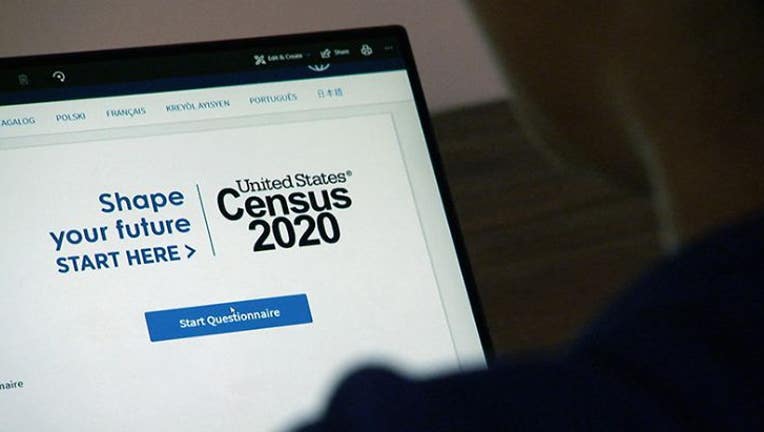Bay Area census response rates robust, but many ethnic groups still at risk of undercount

SAN FRANCISCO BAY AREA - As the U.S. census self-response period is poised to enter its seventh week, all but one Bay Area county is trending above the state and nation when it comes to the percentage of people who have so far participated.
There are many groups, however, that face a serious risk of experiencing an undercount, particularly within Asian and Native Hawaiian and Pacific Islander communities.
As of Thursday, 52.4 percent of people in the United States and 53.8 percent of Californians had filled out the Census Bureau questionnaire, either online, over the phone, or by using a mail-in form.
As of that same day, every Bay Area county except San Francisco, which was at 51.6 percent, had a census-return rate ranging from 55.5 percent (Sonoma) to 62.9 percent (San Mateo.)
"Overall, we are doing quite well compared to the state and national rates, but if you drill down into each county, you are able to see larger disparities in census tracts," said Stephanie Kim, senior director of Census 2020 for United Way of the Bay Area, one of the state's partners in its $187.3 million effort to conduct census-awareness campaigns aimed at hard-to-count populations.
Urban areas are showing slightly lower response rates than suburban communities, for example, and some areas with high concentrations of certain hard-to-count groups are also trending lower than national, state and county returns, Kim said.
That is certainly the case for one of the census tracks that include part of San Francisco's Chinatown, where 93.4 percent of residents are Asian, 78 percent are immigrants, 38 percent live in poverty, 34 percent live in near-poverty, and 75 percent live in households with limited English skills, according to census data.
All of these factors, among others, are considered elements of a hard-to-count population and, as of Thursday, only 37 percent of the area's residents had completed a census form.
This is also the case for an ethnically diverse census tract near downtown San Jose, where the response rate was 39.4 percent Thursday.
The area is predominantly Latino and white but also has distinct Asian and Native Hawaiian and Pacific Islander populations - 38 percent of its households are "Asian and Pacific Islander-speaking," according to census data.
"It is pretty difficult when you look at the response rates," said Talavou Aumavae, chairman of San Mateo County's Pacific Island Complete Count Committee, which also works to ensure census participation in neighboring counties.
"Even in the state of Hawaii, which is filled with Pacific Islanders, the response is pretty low compared to what they expected," Aumavae said.
But because the response rates don't include data on specific racial groups, it's hard to tell exactly who is filling out the forms in any given tract, Aumavae said.
"We don't get a full look at disaggregated groups and minority groups," he said.
Aumavae is hopeful that the numbers will start to trend upward, and said his group is beginning to see positive signs during its census-outreach activities, which have shifted away from in-person contacts to phone banking, social media events and advertising and other remote efforts in the wake of the novel coronavirus pandemic.
In one recent phone-banking drive, volunteers reached out to people who identify as Native Hawaiian or Pacific Islander on voter-registration forms.
"The majority of people we got through to said they completed the census, which is great, but there were some people who didn't know what it was, and so we had volunteers help them right then and there," said Aumavae, who also works for the Peninsula Conflict Resolution Center, which is funding census-outreach efforts.
Aumavae's group is also hosting weekly Facebook events called the "Voices of Oceania Musical Series," which features musicians, DJs and radio hosts who perform or play music for an online audience that is then presented with brief census-awareness segments.
Also, the group staffs a virtual census-questionnaire center that people can call to get help in Samoan and Tongan and, in the near future, Fijian and other relevant languages.
"We had to think of creative ways that we could engage with the community," Aumavae said.
Similar virtual outreach efforts are being organized by Union City's One Myanmar Community, a cultural and immigrant rights organization serving the Bay Area's small but vibrant Burmese community.
The group's president, Myat Soe Mon, said the start of the census coincided with the Burmese New Year, and much of the community outreach was planned around celebratory in-person events.
After the pandemic hit, however, Mon has had to shift focus to social media, phone banks and informational fliers left at grocery stores and other places people are still allowed to go.
"People are using Facebook to understand what is going on with the census," Mon said. "We translate most of the material in Burmese and try to show them pictures and things like that. This is the form that you have, this is how to fill it out."
According to the 2010 census, there were between 30,000 and 50,000 Burmese living in the Bay Area, Mon said, adding that she suspects that number represents a significant undercount.
"I've been telling my community that the census is important for your children, for your community that you live in, because you can get the funding to the county and city that you live in," Mon said.
"On top of that, we get to know how many of our community members are living in the area, so you can know your own community better that way," she said.

